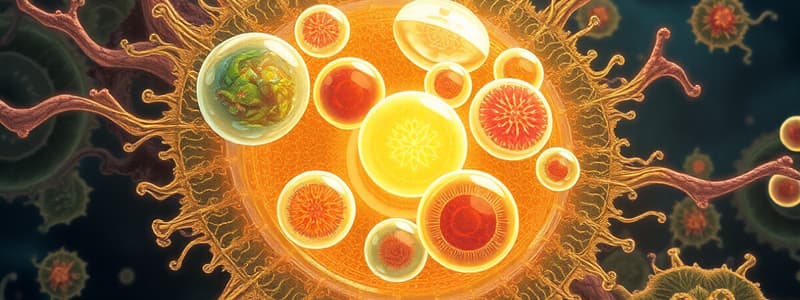Podcast
Questions and Answers
Which cellular structure is responsible for synthesizing proteins?
Which cellular structure is responsible for synthesizing proteins?
- Ribosome (correct)
- Golgi Apparatus
- Endoplasmic Reticulum
- Mitochondria
What is the main function of the Golgi apparatus in a cell?
What is the main function of the Golgi apparatus in a cell?
- Producing energy through cellular respiration
- Detoxifying harmful substances
- Synthesizing proteins
- Modifying, sorting, and packaging proteins (correct)
Which of the following structures is responsible for generating energy in the form of ATP through cellular respiration?
Which of the following structures is responsible for generating energy in the form of ATP through cellular respiration?
- Endoplasmic Reticulum
- Lysosome
- Vacuole
- Mitochondria (correct)
What is the role of lysosomes within a cell?
What is the role of lysosomes within a cell?
Which structure provides a framework for the cell, aiding in cell shape and movement?
Which structure provides a framework for the cell, aiding in cell shape and movement?
In eukaryotic cells, DNA is primarily found within which organelle?
In eukaryotic cells, DNA is primarily found within which organelle?
What is the function of the nuclear membrane?
What is the function of the nuclear membrane?
Which of the following best describes the role of the nucleolus?
Which of the following best describes the role of the nucleolus?
Which type of cytoskeletal element is primarily involved in muscle contraction?
Which type of cytoskeletal element is primarily involved in muscle contraction?
Which of the following is NOT a component of the cytoskeleton?
Which of the following is NOT a component of the cytoskeleton?
What is the role of vacuoles in plant cells?
What is the role of vacuoles in plant cells?
What key process occurs within the endoplasmic reticulum?
What key process occurs within the endoplasmic reticulum?
Which of the following is a primary function of the nuclear pore?
Which of the following is a primary function of the nuclear pore?
What two components make up chromatin?
What two components make up chromatin?
What is the function of the centriole?
What is the function of the centriole?
Which environment is defined by the term 'cytoplasm'?
Which environment is defined by the term 'cytoplasm'?
Which of the following is primarily composed of microtubules and involved in cellular movement?
Which of the following is primarily composed of microtubules and involved in cellular movement?
If a cell needed to increase its production of lipids, which organelle would be most involved?
If a cell needed to increase its production of lipids, which organelle would be most involved?
A researcher observes a cell actively breaking down and recycling damaged organelles. Which organelle is most likely responsible for this function?
A researcher observes a cell actively breaking down and recycling damaged organelles. Which organelle is most likely responsible for this function?
Flashcards
Cell Membrane
Cell Membrane
The outer boundary of the cell, separating its interior from the external environment.
Nucleus
Nucleus
A membrane-bound organelle that contains the cell's genetic material (DNA) and controls cell activities.
Nuclear Membrane
Nuclear Membrane
The double membrane surrounding the nucleus in eukaryotic cells.
Nuclear Pore
Nuclear Pore
Signup and view all the flashcards
Chromatin
Chromatin
Signup and view all the flashcards
Nucleolus
Nucleolus
Signup and view all the flashcards
Endoplasmic Reticulum
Endoplasmic Reticulum
Signup and view all the flashcards
Mitochondria
Mitochondria
Signup and view all the flashcards
Cytoplasm
Cytoplasm
Signup and view all the flashcards
Ribosome
Ribosome
Signup and view all the flashcards
Golgi Apparatus
Golgi Apparatus
Signup and view all the flashcards
Centriole
Centriole
Signup and view all the flashcards
Vacuole
Vacuole
Signup and view all the flashcards
Lysosome
Lysosome
Signup and view all the flashcards
Cytoskeleton
Cytoskeleton
Signup and view all the flashcards
Microfilament
Microfilament
Signup and view all the flashcards
Microtubule
Microtubule
Signup and view all the flashcards
Study Notes
- Cell structures are fundamental components essential for the function of a cell
Cell Membrane
- It is the outer boundary of the cell, separating the internal environment from the external environment
Nucleus
- The command center of the cell, containing most of the cell's genetic material
Nuclear Membrane
- The double membrane structure that surrounds the nucleus, regulating the movement of substances in and out
Nuclear Pore
- A protein-lined channel in the nuclear envelope that regulates the transportation of molecules between the nucleus and the cytoplasm
Chromatin
- The complex of DNA and proteins that form chromosomes within the nucleus
Nucleolus
- A structure that exists in the nucleus and is the site of ribosome synthesis and assembly
Endoplasmic Reticulum
- An extensive network of membranes responsible for protein and lipid synthesis
Mitochondria
- The powerhouses of the cell, generating energy through cellular respiration
Cytoplasm
- The gel-like substance within the cell, excluding the nucleus, where organelles are suspended
Ribosome
- A structure that is the site of protein synthesis
Golgi Apparatus
- An organelle that processes and packages proteins and lipids
Centriole
- A structure that aids cell division
Vacuole
- A storage site for the cells for the storage of water, ions, and nutrients
Lysosome
- It is an organelle responsible for breaking down waste and cellular debris
Cytoskeleton
- A network of protein filament that provide structure, support, and shape to the cell
Microfilament
- Type of cytoskeletal filament that is involved in cell movement and contraction
Microtubule
- Type of cytoskeletal filament that is involved in cell division, support, and transport
Studying That Suits You
Use AI to generate personalized quizzes and flashcards to suit your learning preferences.





